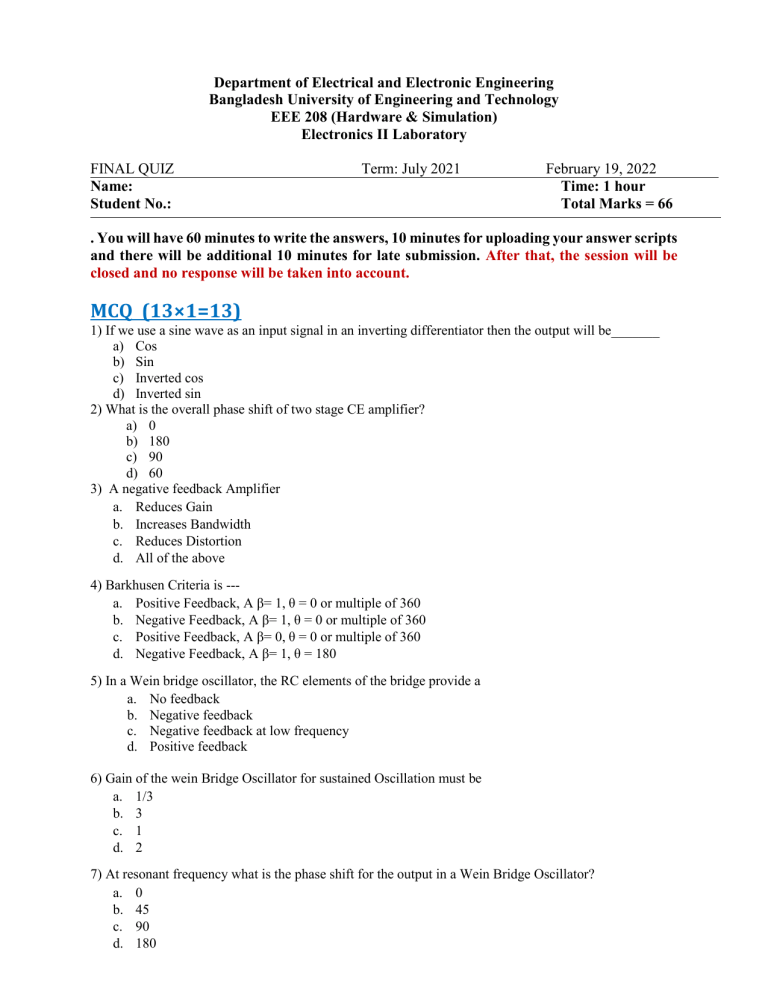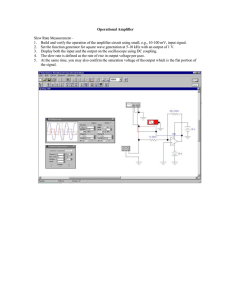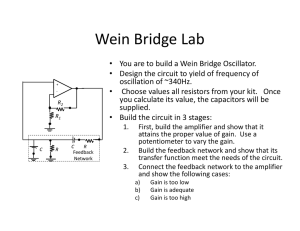
Department of Electrical and Electronic Engineering Bangladesh University of Engineering and Technology EEE 208 (Hardware & Simulation) Electronics II Laboratory FINAL QUIZ Name: Student No.: Term: July 2021 February 19, 2022 Time: 1 hour Total Marks = 66 . You will have 60 minutes to write the answers, 10 minutes for uploading your answer scripts and there will be additional 10 minutes for late submission. After that, the session will be closed and no response will be taken into account. MCQ (13×1=13) 1) If we use a sine wave as an input signal in an inverting differentiator then the output will be_______ a) Cos b) Sin c) Inverted cos d) Inverted sin 2) What is the overall phase shift of two stage CE amplifier? a) 0 b) 180 c) 90 d) 60 3) A negative feedback Amplifier a. Reduces Gain b. Increases Bandwidth c. Reduces Distortion d. All of the above 4) Barkhusen Criteria is --a. Positive Feedback, A β= 1, θ = 0 or multiple of 360 b. Negative Feedback, A β= 1, θ = 0 or multiple of 360 c. Positive Feedback, A β= 0, θ = 0 or multiple of 360 d. Negative Feedback, A β= 1, θ = 180 5) In a Wein bridge oscillator, the RC elements of the bridge provide a a. No feedback b. Negative feedback c. Negative feedback at low frequency d. Positive feedback 6) Gain of the wein Bridge Oscillator for sustained Oscillation must be a. 1/3 b. 3 c. 1 d. 2 7) At resonant frequency what is the phase shift for the output in a Wein Bridge Oscillator? a. 0 b. 45 c. 90 d. 180 8) Where does the Q point lie for class B amplifier? a. Active b. Cut off c. Saturation d. Between Saturation and Active 9) What happens when class B amplifier is in the quiescent? a. No current flows through the transistor b. Maximum current flows through the transistor c. Half of the maximum current flows through the transistor d. Quarter of the maximum current flows 10) Which is the main disadvantage of class B amplifier? a. Expensive b. Less Efficient c. More Power Dissipation d. More heat dissipation 11) Offset voltage can range from ____. a) fV to nV b) pV to uV c) uV to mV d) mV to V 12) For Class A amplifier: a) Operates in the linear region. b) Transistors’ base (or gate) DC biasing voltage is non-zero c) The device is “ON” at all time d) All 13) The maximum frequency generation limit of a Wien-bridge Oscillator isa) 20kHz b) 100kHz c) 1MHz d) 10MHz True/False ( 7×1=7) 1) The Oscilloscope can change frequency of an AC signal. 2) The RC network in the Wien Bridge is low pass filter. 3) The two negative terminals of from two channel of digital oscilloscope are internally shorted. 4) VIO is considered to be a dc error. 5) Offset voltage can affect bias current 6) If no input is given to a practical operational amplifier, we will not see any signal in the oscilloscope. 7) There are 2 types of feedbacks present in a Wien-Bridge Oscillator. Short Note (9×2=18) 1) How to find the value of maximum Voltage gain experimentally for any CE-CE cascaded amplifier for any particular frequency? 2) Without using any oscilloscope, how to check whether a Function Generator is Okay or not? 3) Suppose you have built a Full wave rectifier circuit and obsereved the input and Output Curve in oscilloscope as shown in below. There is no error in your cirucit. Why does the output curve look like this? 4) As we know that for Wien bridge oscillator the ratio of R2/R1 need to be 2. R2 is set at 10K, then why instead of using fixed 5K resistor, a 20K potentiometer is used? 5) You are provided only a oscilloscope along with power supply. How to check whether the oscilloscope is functioning Properly? 6) The output of a 3 level decoder circuit is given below in figure: A. How will you get Figure B in pspice without changing any parameter of the original circuit? 7) Write down 1 advantage and 1 disadvantage of class B power amplifier over Class A. 8) For Class B amplifier shown in the figure, what kind of problem did you face in the simulation for keeping R4 at a very small value compared to R3? And Why? (Consider V1 to be 1V p-p sine wave). Broad Question(4×7=28) 1) The output voltage of a non-inverting amplifier is 8cos(ωt). If the wire connection is re-arranged to make it an inverting amplifier, while keeping the input signal and resistors constant, the output will be 6cos(ωt). If the value of R1 is 2 kΏ, what will be the value of feedback resistor? 2) Complete the figure below by drawing the input signal and Op-Amp. 3) Draw the output voltage V0 of the following figure. 4) Vsat+ =10V, Vsat- = 5V, input =1sinwt a. If R1=R2, Draw the output b. R2= 20R1, Draw the output 5) Figure: simplified circuit Diagram of Feedback amplifier (omitting biasing resistance, capacitance, DC source) Among the four type feedback amplifier (voltage series, current series, voltage shunt, current shunt) Which type of feedback amplifier is shown in the following figure? Expalin Briefly? 6) Why particularly the output oscillation from Wien bridge oscillator is sinusoidal? Not Square wave, triangular or any other form of AC signal? 7) Design a Circuit based on Op-amp which will show following Input Output relation.

